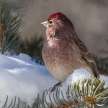
Brewer's Blackbird (Euphagus cyanocephalus) is a blackbird of a small scale in the New World. It is named after Thomas Mayo Brewer, an ornithologist. It's the rising open country blackbird in the West, often seen diving to the ground with fast forward jerks in its eyes. It adapts well to human-modified environments, and can wander outside restaurants on residential sidewalks or scavenge for crumbs. Brewer's Blackbirds gather in large flocks all winter, sometimes with other blackbirds, and foraging can be found in Western and Southern states around the plains. And the rest of the body, adult males have black plumage, with shiny bluish-green highlights on the iridescent purple head and shoulders.
The legs and feet are grey, and the eyes are light pink. The female is brownish-gray, with the male's iridescence providing small traces. Tone of the kid is medium brunette. Actually, they mimic the eastern member of the same species, the rusty blackbird; but, the blackbird of the Brewer has a shorter tail, and the head of the male is iridescent purple. This bird is often mistaken for the common grackle but it does have a shorter tail. The call is likewise a sharp, differentiable test.
This party is in a separate genus than the Eurasian blackbird. The breeding range is open and semi-open plains, mostly near waterways, in both central and western North American regions. The cup nest can be located in different locations: in a tree, in the tall grass or on a wall. They sometimes sleep in pairs. They are also very popular in parking lots, and can quickly acclimatise to people's presence. Walks in bed, searching for food. It wades through the really flaky water as well. It even captures flying insects. It is followed by machinery from the field farm to feed on insects that have turned up the plough. It normally forges in flocks, especially throughout the nesting season. Few nuts, mainly insects and vegetables. Foods from grasshoppers, crickets, bees, aphids, caterpillars, termites to a large number of insects; certain spiders, snails, and even small crustaceans. Eats lots of herbal grass and nuts, and plenty of fresh fruit. Especially in summer they eat berries. Those birds are possibly western permanent residents. Many birds migrate to Mexico and the Southeastern United States. This bird's range in the Great Lakes area has extended toward the east. The bird also nests up to 20-30 pairs, with loose clusters.
Male points bill straight up or backward in courtship display (or occasionally in aggressive display), fluffing out body feathers, and gradually extending wings and legs. The location of the nest is very variable; usually a tree above ground 20-40 ' but it may be on the ground under tall trees, a bush, or in cliff crevices. The female builds dens which is a very large open cup composed of twigs, branches, weeds filled with delicate vegetation, rootlets which animal fur. The nest even lined its foundation with mud or dried manure among certain situations. They lay 4 eggs, and sometimes 3. The eggs are white to light greenish-yellow, brown in spot. The female does the incubation during the 12-14 day. Nestlings are working here now.
Youth leave the nest 13-14 days after hatch. They have 1 brood a year but they will also have 2. They forage in shallow water or in forests, gathering seeds and insects particularly, including berries. Often, they take butterflies on flight. During the breeding season, they feed in flocks, sometimes with other black-birds. The bird is tough, and wild. Throughout the 20th century, it was expanding its influence eastward in the Great Lakes region. The bird may be affected in some areas by competition with Common Grackle, a condition which is rising westward.
About the Creator
MB
I am a bird aficionado and really enjoy spotting them them on hikes. I greatly appreciate the variety of birds cross North America and the world. They are amazing and intelligent creatures, each so unique and with a wonderful life.






Comments
There are no comments for this story
Be the first to respond and start the conversation.